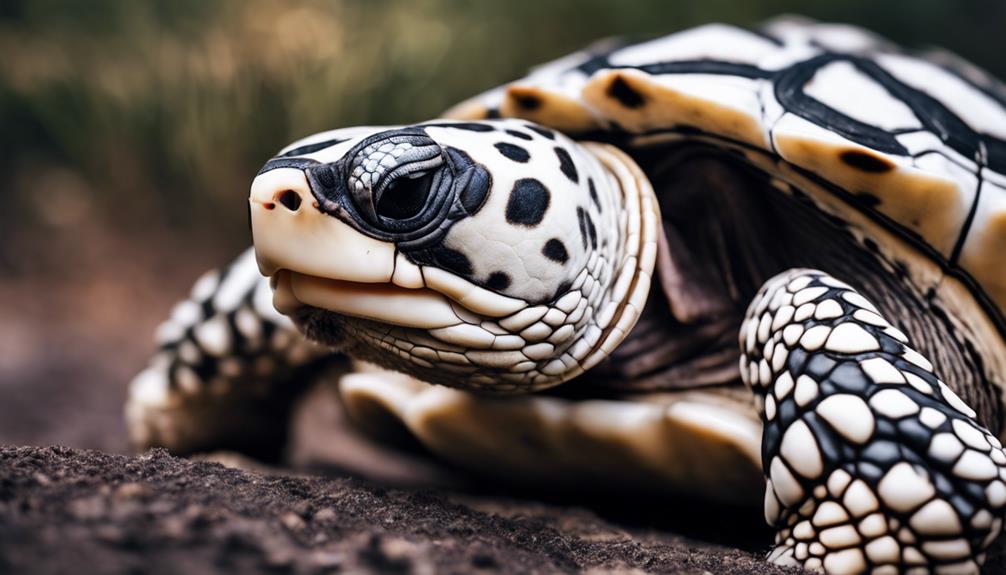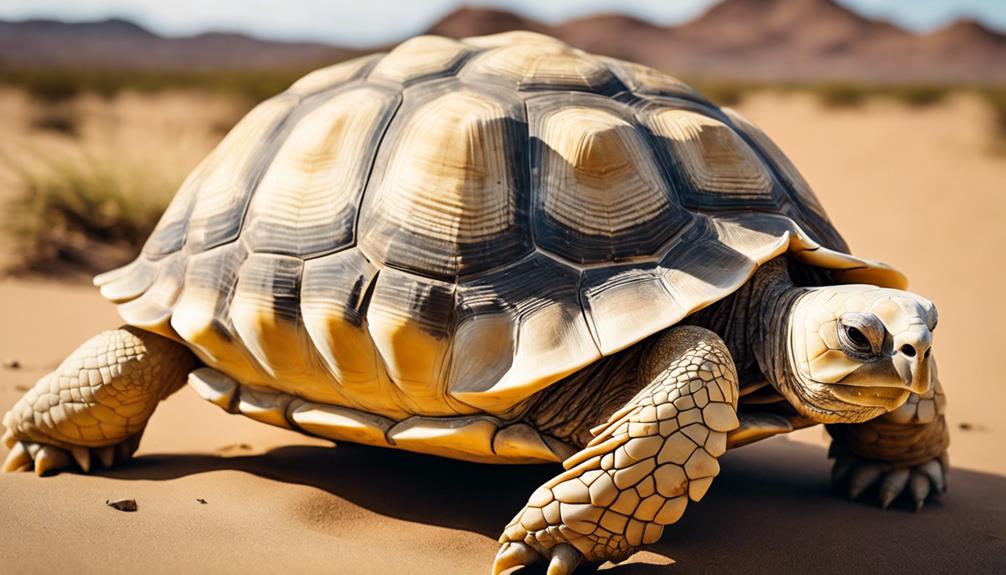You've heard about the intriguing High White Leopard Tortoise, but do you truly understand what sets it apart from other tortoise species?
Its unique genetic makeup influences a distinct feature that captivates enthusiasts worldwide. However, there's more to this fascinating creature than meets the eye.
Stay tuned to unravel the mysteries behind what makes the High White Leopard Tortoise truly exceptional.
Key Takeaways
- High White Leopard Tortoises stand out with their predominantly white carapaces and minimal dark markings.
- Genetic factors and environmental conditions influence their unique white coloration.
- Conservation efforts and responsible ownership practices are vital for their long-term survival.
- Proper nutrition, hydration, and habitat preservation are essential for maintaining healthy populations.
Physical Appearance and Markings
High White Leopard Tortoises exhibit a distinct coloration on their carapaces, characterized by predominantly white or off-white hues with minimal dark markings. This unique color pattern is the result of specific genetic factors that influence shell pigmentation in these tortoises.
The intensity of the white coloring may vary among individuals due to environmental factors and exposure to sunlight. Breeders have taken an interest in preserving and enhancing the high-white trait through selective breeding practices, aiming to produce specimens with the most striking coloration possible.
True High White Leopard Tortoises are rare finds and are highly prized for their distinct appearance, making them sought after by enthusiasts and collectors alike. The rarity of these tortoises adds to their appeal, with their standout coloration setting them apart from other members of the species.
The selective breeding efforts have resulted in a population of High White Leopard Tortoises that showcase the pinnacle of this unique and captivating color variation.
Habitat and Natural Environment
Naturally found in dry, arid habitats with sparse vegetation, the Leopard Tortoise's preferred natural environment includes savannas, grasslands, and scrub forests. These habitats are common in sub-Saharan Africa, the indigenous region of High White Leopard Tortoises. To thrive, they need access to basking spots for soaking up the sun's warmth and shaded areas for cooling off. These tortoises have evolved to adapt to the distinct wet and dry seasons of their habitat, requiring proper temperature gradients to regulate their body temperature effectively. Below is a table illustrating the key features of the Leopard Tortoise's natural environment:
| Habitat | Features |
|---|---|
| Arid Habitats | Sparse Vegetation |
| Savannas | Open Grasslands |
| Scrub Forests | Bushy Areas with Shrubs |
Understanding the intricacies of their habitat sheds light on the remarkable adaptability of High White Leopard Tortoises to survive and thrive in their natural surroundings.
Unique Behaviors and Characteristics
In their natural habitat, the unique behaviors and characteristics of the High White Leopard Tortoise exhibit fascinating adaptations that set them apart from other tortoise species.
High White Leopard Tortoises display a striking white coloration on their carapace, distinguishing them from other leopard tortoise variations. This vibrant white marking, varying in intensity and coverage, is a sought-after trait among collectors and enthusiasts.
Unlike some tortoises, the High White Leopard Tortoise may exhibit minimal pyramiding, enhancing their visual appeal. The distinct white coloration seen in these tortoises is a result of a combination of genetic factors and environmental conditions.
Breeders play a crucial role in preserving and enhancing the high white traits through selective breeding practices, ensuring the uniqueness of these tortoises within the reptile community. The High White Leopard Tortoise's unique traits make them a prized and distinctive member of the reptilian world.
Diet and Feeding Habits
To maintain optimal health and nutrition for High White Leopard Tortoises, a varied diet rich in high-fiber grasses and leafy greens is essential. When catering to their dietary requirements, consider the following key points:
- High-Fiber Diet: Leopard Tortoises are herbivores that thrive on a high-fiber diet consisting of various grasses and leafy greens. Fiber aids in digestion and helps maintain gut health.
- Leafy Greens: Incorporating a variety of leafy greens such as kale, collard greens, and dandelion greens provides essential vitamins and minerals necessary for their well-being.
- Hydration: Access to fresh water is crucial for High White Leopard Tortoises to stay hydrated, aid in digestion, and regulate body temperature.
- Supplementation: Owners should pay special attention to calcium and vitamin supplementation to ensure their tortoise's overall health and prevent deficiencies.
Conservation Status and Threats
Protection efforts for the High White Leopard Tortoise are crucial in mitigating threats to their population and ensuring their long-term survival. While the High White Leopard Tortoise isn't currently listed as a threatened species, conservation practices play a vital role in their preservation. The species benefits from captive breeding popularity, which helps reduce pressure on wild populations. However, threats such as habitat loss and human activity still pose significant risks to Leopard Tortoises.
Captive breeding efforts are instrumental in maintaining healthy population numbers and genetic diversity among High White Leopard Tortoises. By engaging in responsible ownership practices and supporting conservation initiatives, individuals can contribute to the long-term survival of this species. Preserving the natural habitats of Leopard Tortoises is essential for their well-being, as it ensures they've access to suitable environments for feeding, nesting, and breeding. Continued monitoring of threats and proactive conservation measures are essential to safeguard the High White Leopard Tortoise population for future generations.
Conclusion
In conclusion, the High White Leopard Tortoise is a truly unique and captivating species, with its striking genetic influence on shell color and varying color intensity due to sunlight exposure.
Like a rare gem shimmering in the sunlight, these tortoises stand out in the tortoise community for their distinctive appearance and sought-after characteristics.
Their rarity and beauty make them a prized addition to any collection, adding a touch of elegance and intrigue to any habitat.


